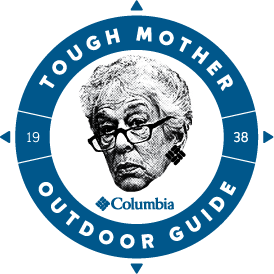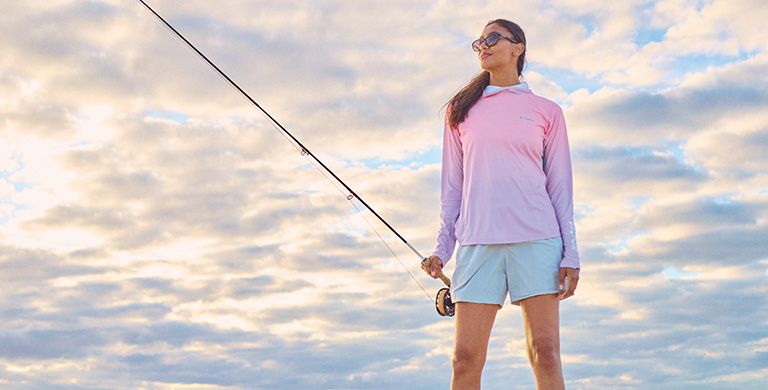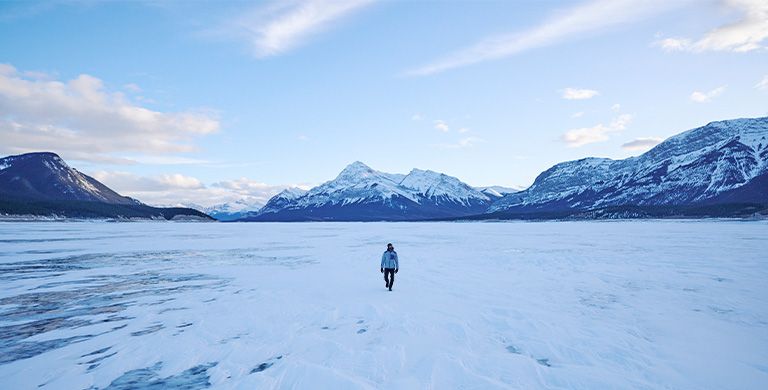TECHNOLOGY
Insect Shield™ Repellant Apparel From Columbia
Enjoy proven, invisible protection in apparel with built-in Insect Shield™ technology
BY: NANCY BOUCHARD
Bugs may be the backbone of the outdoors, but unless you’re an entomologist—someone who voluntarily studies the six-legged creatures most of us are trying to swat—you avoid them at all costs. Sure, they help pollinate plants, break down organic matter, and feed birds, fish, and other wildlife, but they’re a menace when you’re trying to hike, fish, paddle, run, or simply enjoy sitting around the campfire.
Mosquitoes, flies, ants, chiggers, and midges—you read that right—are all part of nature. Some just want to ruin your day; others want to ruin your life. These tiny tyrants don’t just bite; they spread disease and pose serious public health risks. It doesn’t matter if you’re in your backyard or backwoods—nothing kills an outdoor adventure faster than a night of relentless itching or worrying that the bite might leave more than just an annoying mark.
A mosquito’s proboscis—just 1.4 to 3 mm long—effortlessly pierces light cotton, making T-shirts and track shorts an open invitation for bites. While heavier fabrics like denim or canvas provide better protection, wearing thick layers—or worse, rain gear—in the summer is hardly practical or comfortable. You could douse yourself in bug spray, but coating your entire body in chemicals isn’t ideal, and natural repellents often fall short. The best defense? A combination approach. Your best protection is wearing loose-fitting fabrics that help block mosquito bites—especially when treated with Insect Shield™.
Mosquitoes, flies, ants, chiggers, and midges—you read that right—are all part of nature. Some just want to ruin your day; others want to ruin your life. These tiny tyrants don’t just bite; they spread disease and pose serious public health risks. It doesn’t matter if you’re in your backyard or backwoods—nothing kills an outdoor adventure faster than a night of relentless itching or worrying that the bite might leave more than just an annoying mark.
A mosquito’s proboscis—just 1.4 to 3 mm long—effortlessly pierces light cotton, making T-shirts and track shorts an open invitation for bites. While heavier fabrics like denim or canvas provide better protection, wearing thick layers—or worse, rain gear—in the summer is hardly practical or comfortable. You could douse yourself in bug spray, but coating your entire body in chemicals isn’t ideal, and natural repellents often fall short. The best defense? A combination approach. Your best protection is wearing loose-fitting fabrics that help block mosquito bites—especially when treated with Insect Shield™.

Why Insect Shield?
Columbia has done extensive research into apparel that protects from insects. Explains Haskell Beckham, Columbia’s VP of Innovation, “When we started looking into insect-protective solutions, we didn’t have one in our product line—but we definitely needed one. It’s a growing problem as the planet warms, mosquito territory expands, and the biting season gets longer.”
“With that in mind, we explored various approaches, considering numerous repellent chemistries and their challenging regulatory requirements,” says Beckham. While sifting through research, something unexpected caught Beckham’s eye, a scientific report on why zebras have stripes. Contrary to common belief that the stripes served as camouflage or helped with heat regulation, new data suggested that the pattern actually “disrupts the optical path of biting black flies, leading to fewer bites.” Researchers had tested this by painting patterns on cows and horses, then tallying up the number of fly landings. That raised an intriguing question: do high-contrast patterns on clothing work against mosquitoes too?
To find out, Haskell dug deeper. “We did some literature research and discovered some data that seemed unhelpful—mosquito vision sucks compared to flies—and some data that seemed helpful—mosquito landings can be affected by patterns, gloss, and color.” From there, extensive testing ensued—cage testing, blood membrane testing—yielding a mix of “very promising results, but also some poor results depending on conditions.” A key concern remained--even if the visual deterrent worked, “it might not work at night when vision is much less effective in targeting.”
Ultimately, the research reinforced an inconvenient truth, mosquitoes are relentless. The bottom line is that mosquitoes target by smell, heat, CO₂, as well as vision. Thus, even if one targeting mechanism is blocked, others can be employed. “They are extremely difficult to deter,” explains Beckham. “We opted to go with the built-in protection of Insect Shield™.”
“With that in mind, we explored various approaches, considering numerous repellent chemistries and their challenging regulatory requirements,” says Beckham. While sifting through research, something unexpected caught Beckham’s eye, a scientific report on why zebras have stripes. Contrary to common belief that the stripes served as camouflage or helped with heat regulation, new data suggested that the pattern actually “disrupts the optical path of biting black flies, leading to fewer bites.” Researchers had tested this by painting patterns on cows and horses, then tallying up the number of fly landings. That raised an intriguing question: do high-contrast patterns on clothing work against mosquitoes too?
To find out, Haskell dug deeper. “We did some literature research and discovered some data that seemed unhelpful—mosquito vision sucks compared to flies—and some data that seemed helpful—mosquito landings can be affected by patterns, gloss, and color.” From there, extensive testing ensued—cage testing, blood membrane testing—yielding a mix of “very promising results, but also some poor results depending on conditions.” A key concern remained--even if the visual deterrent worked, “it might not work at night when vision is much less effective in targeting.”
Ultimately, the research reinforced an inconvenient truth, mosquitoes are relentless. The bottom line is that mosquitoes target by smell, heat, CO₂, as well as vision. Thus, even if one targeting mechanism is blocked, others can be employed. “They are extremely difficult to deter,” explains Beckham. “We opted to go with the built-in protection of Insect Shield™.”

Designed from Experience
Columbia’s product designers don’t just sketch ideas in a vacuum—they head into the wild and let Mother Nature do the talking. To create Columbia’s latest Skien Valley Collection with built-in Insect Shield™ technology, members of the Columbia sportswear and outerwear design teams drove several hours to a remote lake in SE Oregon.
“We arrived in the early evening and began setting up camp. Everyone was feeling excited for the days ahead,” remembers Erin Schmitt, Senior Apparel Designer, Columbia Sportswear. “As we began setting up our dining area, we noticed several large flies buzzing around. As the sun started to set, the flies increased and began to attack our site. People were layering on extra sweatshirts and light jackets because the flies were biting through thin materials. They were aggressive and impossible to escape!”
Mother Nature’s assault didn’t stop there. “Once the sun fully set, the flies disappeared and soon the mosquitos came out,” says Schmitt. “It was peak summer, and we were close to water, so there were a lot of mosquitos in no time. We quickly realized that we didn’t have a lot of on-body protection against these bugs, and I don’t think we expected this level of bugs on this trip—my ankles were covered in bites.” That experience underscored the need for better on-body protection. Back in the design studio, Schmitt and her team set out to solve the problem.
After experiencing firsthand how bugs could bite through thin layers, Schmitt collaborated with designers Nancy Zan and Lauran Fryan to develop functional, protective apparel. “We focused on solutions that offer real protection,” says Schmitt. “For men’s, we landed on a woven long-sleeve shirt, a woven zip hoodie, a knit hoodie, and woven pants. A highlight is the fine stretch power mesh, which adds an extra layer of protection at openings like the hood and vents to keep bugs out.”
Fryan, Senior Apparel Designer for Columbia’s Women’s Collection, emphasizes balancing function and style. “We used lightweight fabrics plus lots of pockets for ample storage,” she says. “Adjustable hems, hoods, and collars offer full coverage to help keep those nasty bugs out.”
Most importantly, Fryan adds, “For our women’s pieces, wanted to ensure these designs had subtle touches like a cropped hoodie, parachute-style pants, and a woven shirt with chest pockets that add storage without too much volume in the bust. Sitting at the campsite, surrounded by insects, we all agreed: easy, lightweight protection was essential. Our experience in the Oregon outback inspired the designs we’re bringing to market.”
“We arrived in the early evening and began setting up camp. Everyone was feeling excited for the days ahead,” remembers Erin Schmitt, Senior Apparel Designer, Columbia Sportswear. “As we began setting up our dining area, we noticed several large flies buzzing around. As the sun started to set, the flies increased and began to attack our site. People were layering on extra sweatshirts and light jackets because the flies were biting through thin materials. They were aggressive and impossible to escape!”
Mother Nature’s assault didn’t stop there. “Once the sun fully set, the flies disappeared and soon the mosquitos came out,” says Schmitt. “It was peak summer, and we were close to water, so there were a lot of mosquitos in no time. We quickly realized that we didn’t have a lot of on-body protection against these bugs, and I don’t think we expected this level of bugs on this trip—my ankles were covered in bites.” That experience underscored the need for better on-body protection. Back in the design studio, Schmitt and her team set out to solve the problem.
After experiencing firsthand how bugs could bite through thin layers, Schmitt collaborated with designers Nancy Zan and Lauran Fryan to develop functional, protective apparel. “We focused on solutions that offer real protection,” says Schmitt. “For men’s, we landed on a woven long-sleeve shirt, a woven zip hoodie, a knit hoodie, and woven pants. A highlight is the fine stretch power mesh, which adds an extra layer of protection at openings like the hood and vents to keep bugs out.”
Fryan, Senior Apparel Designer for Columbia’s Women’s Collection, emphasizes balancing function and style. “We used lightweight fabrics plus lots of pockets for ample storage,” she says. “Adjustable hems, hoods, and collars offer full coverage to help keep those nasty bugs out.”
Most importantly, Fryan adds, “For our women’s pieces, wanted to ensure these designs had subtle touches like a cropped hoodie, parachute-style pants, and a woven shirt with chest pockets that add storage without too much volume in the bust. Sitting at the campsite, surrounded by insects, we all agreed: easy, lightweight protection was essential. Our experience in the Oregon outback inspired the designs we’re bringing to market.”

The Verdict
Columbia’s Skien Valley clothing line is lightweight, breathable, and unlike bug spray, the Insect Shield™ technology remains effective for up to 70 washes, outlasting the typical lifespan of the garment. There’s no worry that you’ll lose protection mid-adventure.
Beyond bug protection, many of the Skien Valley garments with Insect Shield™ technology also come with Columbia’s Omni-Shade™ technology, offering UPF 30 to 40 protection against harmful UV rays. Plus, with Columbia’s Omni-Wick™ technology, moisture is wicked away from your skin, so you stay dry and comfortable whether you’re hiking, fishing, or just trying to survive mosquito season.
Beyond bug protection, many of the Skien Valley garments with Insect Shield™ technology also come with Columbia’s Omni-Shade™ technology, offering UPF 30 to 40 protection against harmful UV rays. Plus, with Columbia’s Omni-Wick™ technology, moisture is wicked away from your skin, so you stay dry and comfortable whether you’re hiking, fishing, or just trying to survive mosquito season.
The next time you head outside to fish, hike, camp, or work - gear up with
Columbia apparel featuring Insect Shield™ for invisible, odorless, and long-lasting insect protection.
Columbia apparel featuring Insect Shield™ for invisible, odorless, and long-lasting insect protection.



